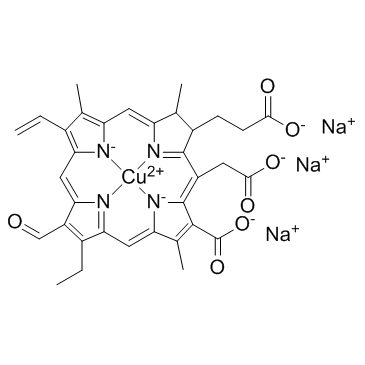28302-36-5
| Name | copper,trisodium,3-[(2S,3S)-20-(carboxylatomethyl)-18-(dioxidomethylidene)-8-ethenyl-13-ethyl-3,7,12,17-tetramethyl-2,3-dihydroporphyrin-23-id-2-yl]propanoate |
|---|---|
| Synonyms |
Copper(2+) trisodium 3-[(2Z,7Z,11Z,16Z)-2-(carboxylatomethyl)-20-(dioxidomethylene)-15-ethyl-5,9,14,19-tetramethyl-10-vinyl-21,22,23,24-tetraazapentacyclo[16.2.1.1.1.1]tetracosa-1(21),2,6(24),7,9,11,13(22),14,16,18-decaen-23-id-4-yl]propanoate
21H,23H-Porphine-7-propanoic acid, 3-carboxy-5-(carboxymethyl)-13-ethenyl-18-ethyl-7,8-dihydro-2,8,12,17-tetramethyl-, copper(2+) salt, (7S,8S)- (1:1) copper(2+) (2S,3S)-18-carboxy-2-(2-carboxyethyl)-20-(carboxymethyl)-8-ethenyl-13-ethyl-3,7,12,17-tetramethyl-2H,3H-porphine-22,23-diide SodiuM Copper Chlorophyllin Copper(2+) trisodium 3-[20-(carboxylatomethyl)-18-(dioxidomethylene)-13-ethyl-3,7,12,17-tetramethyl-8-vinyl-3,18-dihydro-2H-porphin-22-id-2-yl]propanoate copper(2+) (2S,3S)-7-carboxy-3-(2-carboxyethyl)-5-(carboxymethyl)-17-ethenyl-12-ethyl-2,8,13,18-tetramethyl-2H,3H-porphine-22,24-diide 2H,3H-porphine-2-propanoic acid, 20-(carboxymethyl)-18-(dihydroxymethylene)-8-ethenyl-13-ethyl-18,22-dihydro-3,7,12,17-tetramethyl-, copper(2+) sodium salt (1:1:3) Kupfer(2+)trinatrium-3-[(5Z,10Z,14Z,19Z)-5-(carboxylatomethyl)-3-(dioxidomethyliden)-13-ethenyl-18-ethyl-2,8,12,17-tetramethyl-3,7,8,23-tetrahydroporphin-23-id-7-yl]propanoat Copper(2+) trisodium 3-[20-(carboxylatomethyl)-18-(dioxidomethylidene)-8-ethenyl-13-ethyl-3,7,12,17-tetramethyl-3,18-dihydro-2H-porphin-22-id-2-yl]propanoate Copper(2+) sodium 3-(2-carboxylatoethyl)-5-(carboxylatomethyl)-12-ethyl-2,8,13,18-tetramethyl-17-vinyl-2H,3H-porphine-22,24-diide-7-carboxylate (1:3:1) 21H,23H-Porphine-7-propanoic acid, 3-carboxy-5-(carboxymethyl)-13-ethenyl-18-ethyl-7,8-dihydro-2,8,12,17-tetramethyl-, copper(2+) sodium salt (1:1:3) Copper(2+) (2S,3S)-7-carboxy-3-(2-carboxyethyl)-5-(carboxymethyl)-12-ethyl-2,8,13,18-tetramethyl-17-vinyl-2H,3H-porphine-22,24-diide |
| Description | Sodium copper chlorophyllin exerts antiviral activities against Influenza virus and HIV with IC50s of 50 to 100 μM for both of them. |
|---|---|
| Related Catalog | |
| Target |
IC50: 50 to 100 μM (Influenza virus), 50 to 100 μM (HIV)[1] |
| In Vitro | Sodium copper chlorophyllin exhibits influenza virus adsorption at 200 µM (P<0.05). The 50% inhibitory concentration (IC50) and the 50% cytotoxic concentration (CC50) of Sodium copper chlorophyllin lay from 50 to 100 µM and 200 to 400 µM, respectively. Sodium copper chlorophyllin also inhibits HIV adsorption at 2.5 mM (P<0.05). The IC50 and CC50 of Sodium copper chlorophyllin lay from 50 to 100 µM and 200 to 400 µM, respectively[1]. |
| Cell Assay | MT-2 cells are pre-incubated to the bamboo leaf extract solution (up to 10%), Sodium copper chlorophyllin (up to 5 mM) or test reagent-free culture medium for 10 min to assess the inhibitory activity at adsorption. The pre-incubated cells are washed extensively to be able to eliminate antiviral activity of test reagents remaining in the culture medium, and then they are exposed to HIV-1LAI (1.3×10-4 TCID50 per cell). In addition to these pre-incubated cells, control wells are prepared to evaluate growth of the cells in a virus-free condition. Then, virus-exposed and mock-exposed cells are cultured in the absence of test reagents for three days. The total viable cells are counted on day 3[1]. |
| References |
| Boiling Point | 790ºC at 760mmHg |
|---|---|
| Molecular Formula | C34H29CuN4Na3O7 |
| Molecular Weight | 738.13 |
| Flash Point | 431.6ºC |
| PSA | 187.96000 |
| Safety Phrases | 22-24/25 |
|---|---|
| WGK Germany | 2 |
| RTECS | GS2168866 |
